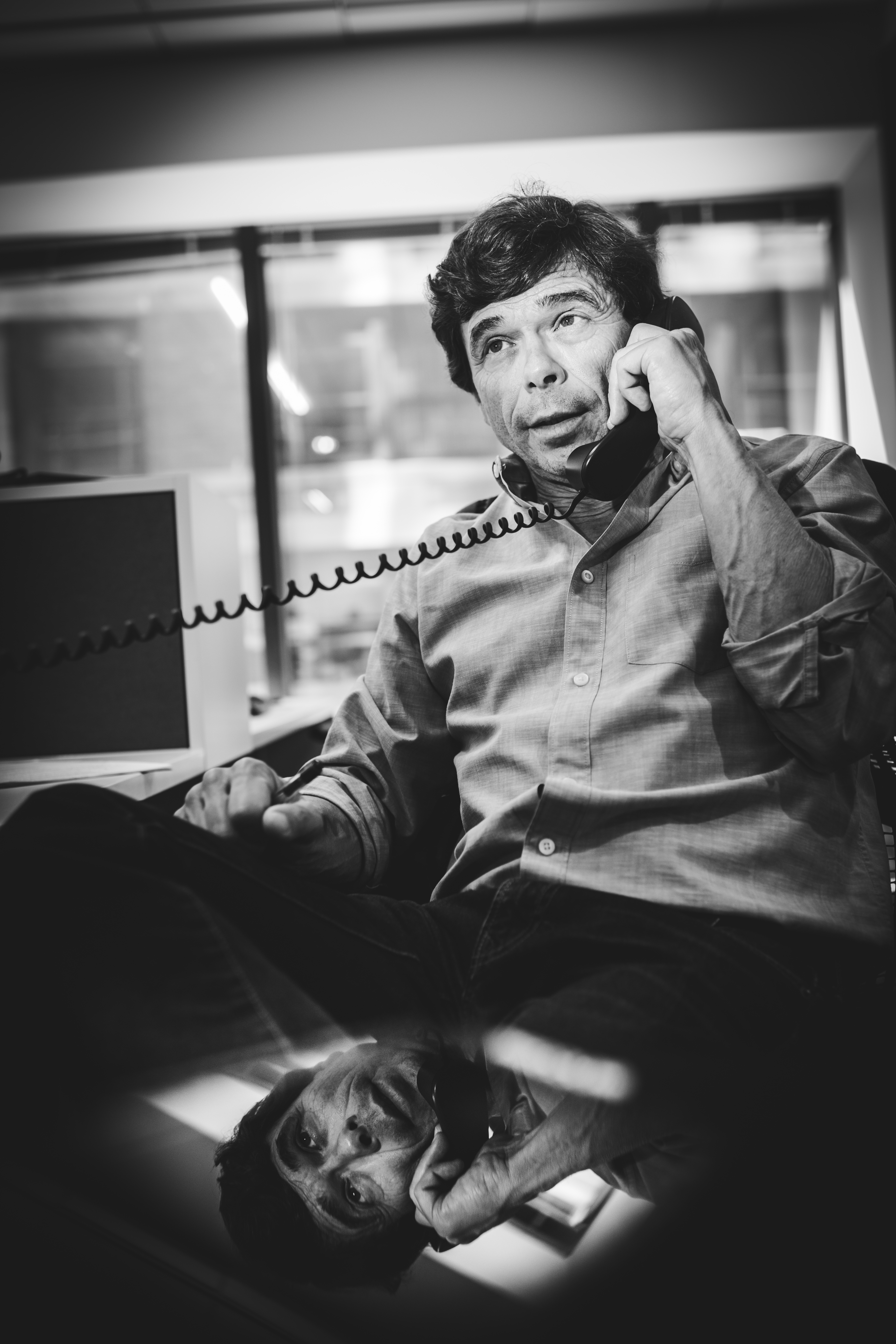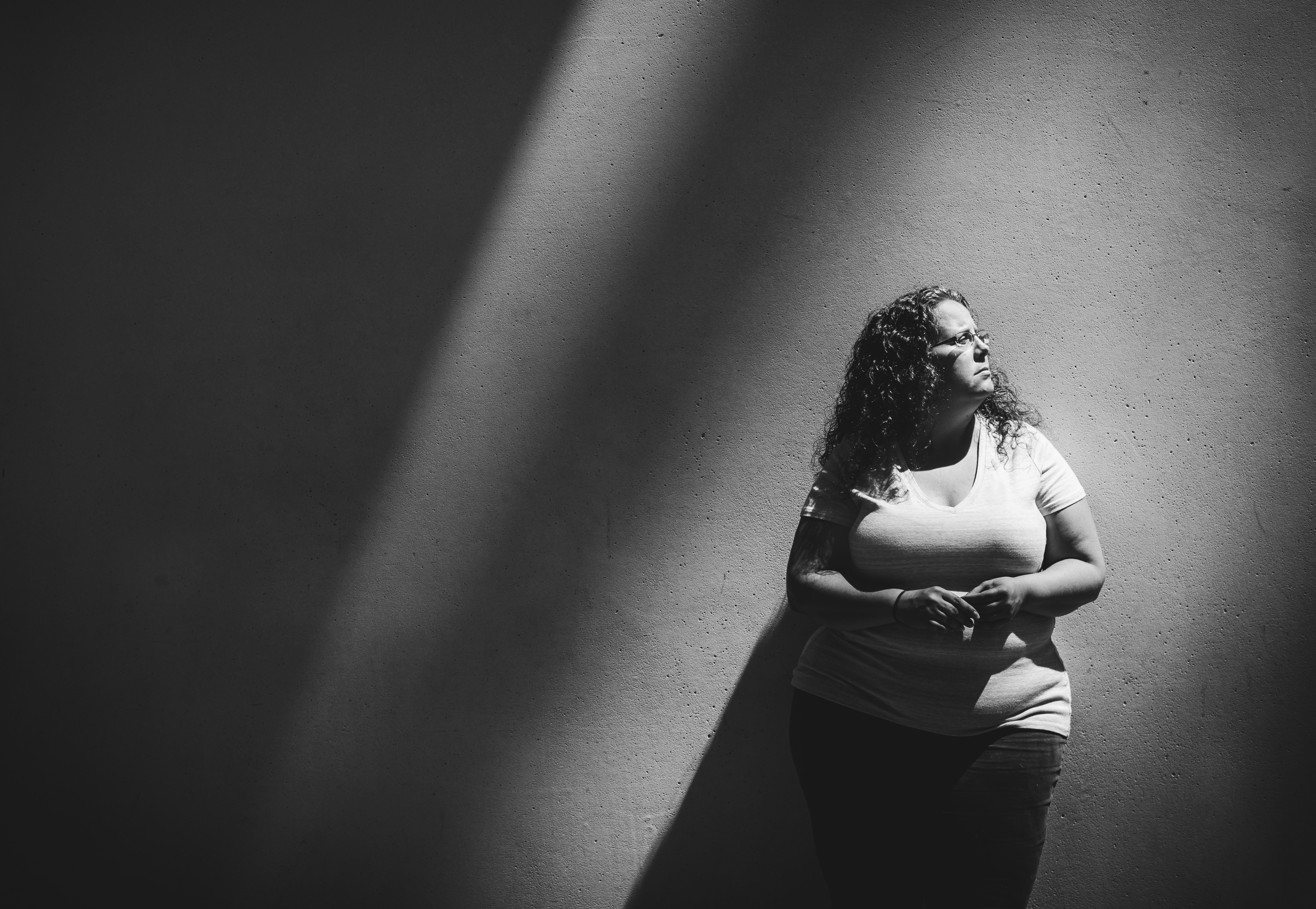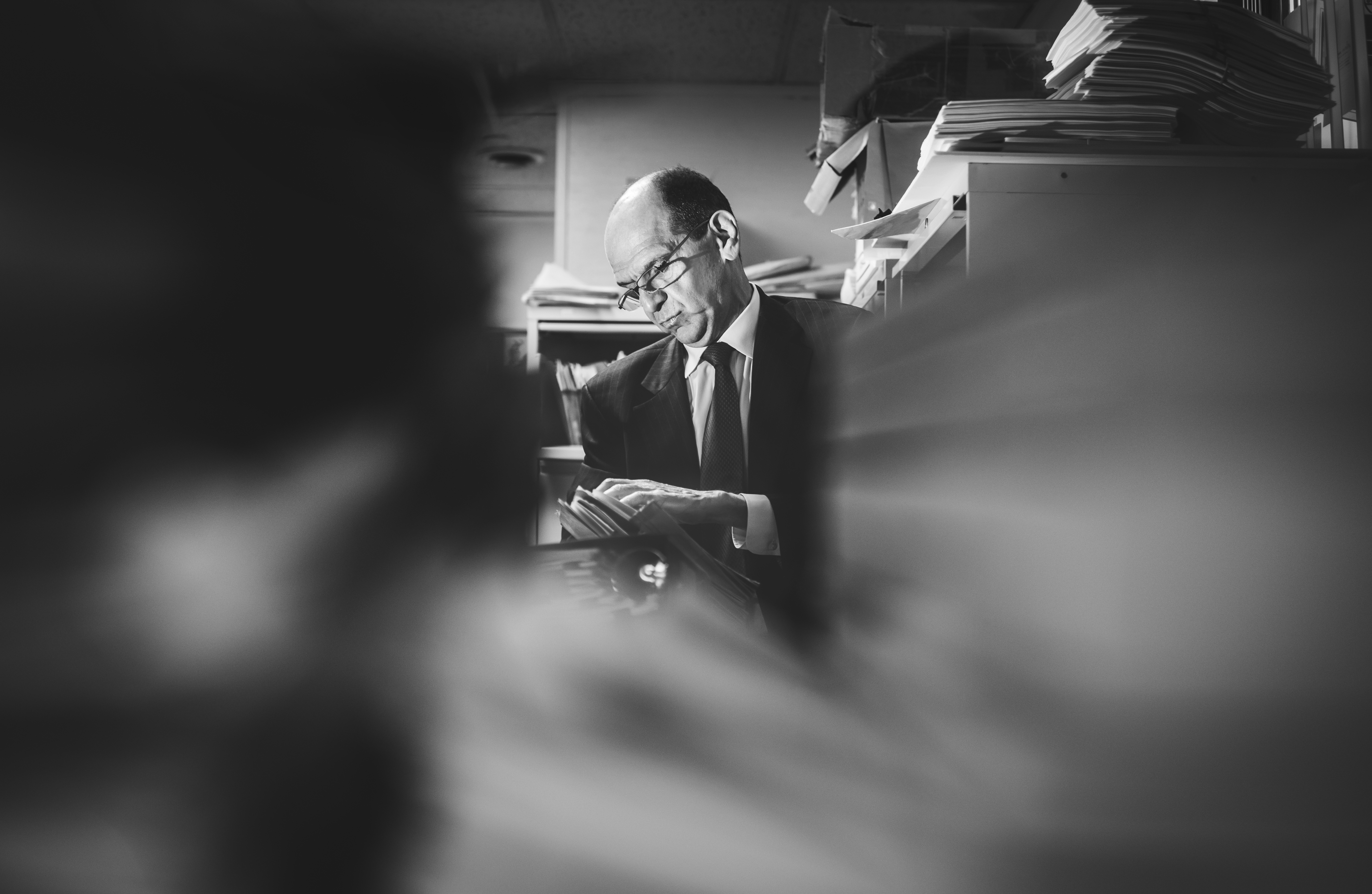Crusading Lawyer
By Lara Ehrlich
MITCHELL GARABEDIAN: In 1994, a client came to me for help. She said, “I would like you to speak to my three children, because I can’t figure out what is going on.” One boy was washing his hands every day until they bled. Another boy was taking two-hour showers. And the oldest boy was violent with his younger brothers. This was a fatherless family. We’d shoot the breeze. I talked to them about what they did during the day, about baseball, school, friends, who visited them. And you could see their attitude, tone, and demeanor change when it came to the priest who visited them. All of a sudden, they would become very nervous. They would clam up. They lived in the projects in Waltham, and my client had me speak to her girlfriends, her neighbors, and some of her relatives. The priest was Father John J. Geoghan, and before I knew it I had dozens of children who were acting the same way, who had all been visited by Geoghan. He took them for ice cream, then molested them, fondled them in bed. I’ve got Geoghan abusing children over the course of 36 years—36 years! And it’s not unusual, unfortunately. I’ve got 154 claims against Geoghan. That’s one priest. There have been thousands of others; each priest has probably molested hundreds of children. Hundreds. Each one. GLEN KACHADORIAN (a childhood friend): Mitch always fought against bullies. We’d all pile into his van, and Mitch would drive us around Boston. I recall several times when all of a sudden, he would be out of the van and in somebody’s face when he saw something he didn’t like. He was a wildcat. He was pretty brave, even then. MICHAEL REZENDES (CAS’78) (Boston Globe Spotlight reporter): When Mitchell began representing victims of clergy sex abuse, he took all these cases on a pro bono basis. That means you don’t get paid unless you win a judgment. They were going up against the Catholic Church, and those are long odds right there. It’s a very powerful institution, and Mitch was basically a solo practitioner. A lot of his clients were pretty damaged, and I think many lawyers would have been reluctant to take them on. They might consider them unreliable, might start imagining how a jury would react to these clients on the stand. But Mitchell, he took them on. ALEXA MACPHERSON (a Garabedian client): I was three or four when it started. I would be coloring at the dining room table, and Father Kanchong would put me on his lap. I always thought it was like a pack of Lifesavers in his pocket. And then I would feel wet on my pants, and it would be him ejaculating. He would come over for lunch. He would come over for dinner. Birthday parties, weddings—you name it, he was there. The only break I ever got from him was when I went to Disney for a week. Other than that, I saw him every day of my life until the day he was caught. He would threaten my animals, would threaten me, would tell me my mother and father won’t love me anymore. They’ll send me away. This is how you show respect to a priest. Two of my brothers were molested and raped by the same priest. He said he would get my brother locked up, because he was dabbling in drugs and alcohol and attempted suicide, all stemming from the abuse. I was nine and a half when my father caught him trying to rape me on the living room couch. Because of how much I had been threatened, I said it was just a one-time thing, even though it had been happening on almost a daily basis for many, many years. It’s not like my brothers, who got through the bulk of their childhoods and had created memories before the abuse started. My life was the abuse. I was a senior in high school when my brother asked me to come forward with him. We tried to pursue Kanchong, but we weren’t able to prosecute him criminally because the statute of limitations had run out. Then one day, my brother’s ex-wife was reading an article about Mitchell Garabedian, the lawyer handling the James Porter clergy abuse case. She called him for us, and he said, “Come on in.” Mitchell was one of the very first people who, with no strings attached, said, “I believe you. Now here’s what I’m going to do for you.” GARABEDIAN: This was not a monetary endeavor for me. It was like, if I go broke doing this, I go broke doing this. Senior lawyers would stop me on the street and say, “The church is going to crush you.” I just said, “This has to be done. It’s cruel, it’s evil.” How could I not do this? What kind of value do I have as a human being? What kind of person am I? KACHADORIAN: He was a pit bull, and he was always underestimated by the old Boston lawyers, who thought, “Oh, we can handle this kid.” Well, he’d outmaneuver them constantly. He’d just conquer in court. BOSTON GLOBE (Spotlight report, January 6, 2002): [F]or all Geoghan’s notoriety, the public record is remarkably skeletal. That is because almost all the evidence in the lawsuits about the church’s supervision of Geoghan has been under a court-ordered confidentiality seal granted to church lawyers. GARABEDIAN: Because of the First Amendment’s establishment clause, we couldn’t just go to court and say we wanted to look at the church’s conduct. Based on documents we had that indicated wrongful conduct, I had to file a motion to obtain further documents, until finally we were able to establish enough evidence to ask the judge to allow us to obtain the Secret Files, which held the most incriminating evidence. Canon Law states in writing, “Sexual abuse cases, when looked into, should be kept secret.” Canon Law also says church officials had to keep records of complaints and personnel issues. There were more than 10,000 documents on Geoghan alone. In Canon Law, they are really called the Secret File
REZENDES: Mitchell was able to take the most explosive of the church documents that had been sealed by a judge and get them onto the public record. Those documents led to the first Spotlight story—but it was Mitchell’s strategy of getting them into the public record that allowed me to finally get my hands on them. GARABEDIAN: The import of the Secret Files was that they showed Cardinal Bernard Law knew that Geoghan was sexually molesting children before he transferred him to St. Julia’s Parish in Weston and didn’t warn the parishioners. BRIEF FILED BY PLAINTIFFS’ COUNSEL (in Gregory Ford, et al., v. Bernard Cardinal Law, et al., July 21, 2003): Although notice that Geoghan was unsuitable to interact with minors was given as early as 1979, when allegations were made against Father Geoghan and were reported to Bishop Daily, Father Geoghan was thereafter continuously moved from parish to parish to victimize others. GARABEDIAN: When they receive a hot complaint—a mother saying, “Do something”—their idea of doing something is not to report the priest to the police or warn the parishioners, it is to get him out of Dodge. They just transfer, transfer. MACPHERSON: All they wanted to protect was the appearance of the church. They didn’t care about what Kanchong did to me. They didn’t investigate it. They didn’t report him. They turned him loose. They turned their backs. FROM THE SECRET ARCHIVE (Letter from Cardinal Bernard Law, archbishop emeritus of Boston, to Bishop Joseph Thabping of Thailand): Father Peter [Kanchong] now has a charge of child molestation against him. At this time the court is attempting to handle the matter in such a way as to help Father Peter and avoid scandal to the Church and the priesthood….Your Excellency, I write at this time to respectfully request that you immediately recall Father Peter Kanchong to your diocese. His continued presence in the Archdiocese of Boston runs the risk of serious personal harm and grave scandal for the Church. GARABEDIAN: Now, they had—and still have—centers for the treatment of pedophilia. Another sham. They use code words like “alcoholism” when they send priests to these treatment centers, and they pay the centers a lot of money to say what the supervisors of the church would want them to say. BRIEF FILED BY PLAINTIFFS’ COUNSEL (in Gregory Ford, et al., v. Bernard Cardinal Law, et al., July 21, 2003): In 1989, Geoghan spent months in two institutions purporting to specialize in the treatment of sexually abusive priests—St. Luke Institute in Maryland, where he was diagnosed with “homosexual pedophilia,” and the Institute of Living in Hartford, Connecticut, where he was diagnosed with “A Typical Pedophilia”—it was recommended that “he be returned to assignment; keep in touch with psychiatrist.” On November 13, 1989, Father Geoghan was reassigned to full ministry at St. Julia’s by Cardinal Law. REZENDES: In Massachusetts, we have the doctrine of charitable immunity; what that means is if you sue a charity, you can’t collect more than $20,000. So, Mitchell sued Geoghan’s superiors instead. He filed 84 lawsuits on behalf of Geoghan’s victims, and those cases were settled without trial. In most of the cases, the statute of limitations had expired—but Geoghan had recently groped a boy in the swimming pool at the Waltham Boys and Girls Club, and the statute of limitations had not yet expired. Geoghan was tried criminally and convicted of sexual assault. He was murdered in prison. Cardinal Law resigned as archbishop of Boston and fled to the Vatican, where he was appointed the archpriest of the Basilica of St. Mary Major, one of the most significant churches in Rome. BOSTON GLOBE (Spotlight report, December 14, 2002): Like jarring aftershocks from a mighty earthquake, Boston’s clergy sexual abuse scandal has registered around the world, provoking what some scholars have called the worst crisis in the Catholic Church in 500 years. Within weeks of Globe reports in January about the Archdiocese of Boston’s secret settlement of child molestation claims against at least 70 priests, dioceses around the country were forced to confront the consequences of their own policies about sexually abusive clergymen. ROBERT HOATSON (a Garabedian client and the founder of Road to Recovery, a nonprofit that assists victims of clergy sex abuse): I was a Catholic priest, and I am a victim myself of childhood sexual abuse. I testified in May 2003 before the New York State Legislature, and I was fired by the archbishop of my district for calling for the resignation of any bishop who has covered up sex abuse. I had been directing two inner-city schools in the Archdiocese of Newark, and the priest who replaced me was removed four months later because he inappropriately touched an eighth grade boy. That boy was in our school because he had already been touched inappropriately in fourth grade, in the parish next door. The church is definitely a magnet to abusers. For anybody who is petrified of their sexuality, it’s a great place to hide, because you don’t have to deal with it. But it’s such a strong urge that the altar boy, when he’s alone with the priest, begins to look like somebody he can have power over. MACPHERSON: You’ve got the priest telling you this is how you obey God, and you don’t want God to be mad at you—worse yet, you don’t want your mother to be mad at you, do you? You want to tell her you disobeyed a priest? HOATSON: We’re told that the priest is the closest thing to God on earth, and therefore what the priest says is gospel. Do you know what the priest says? “No one’s going to believe you.” Who are they going to believe: the nine-year-old or the priest? MACPHERSON: How do you tell your mother, who’s extremely religious, that a priest is molesting you? I didn’t even know those words. It’s what I grew up with, so how did I know it was wrong?
HOATSON: With clients, Mitch is as sensitive and compassionate as can be. One of his favorite lines is, “I’m very sorry to have to ask you this.” I don’t know how many times Mitch says that while he’s interviewing a client. Then he says, “But I have to know the whole story.” He has us sign releases sent to our elementary school, high school, colleges, doctors. He gets medical records and criminal reports, and he puts together this package—always with the intention of proving your story, rather than proving you’re wrong. GARABEDIAN: The damages are endless and everlasting for many victims. When you meet victims, you see an adult, but picture that person as a child and see how vulnerable they are. Many victims still have that little afraid child in them who was sexually abused. MACPHERSON: I was part of an $86 million settlement with over 500 people. It came down to the fact that there were so many of us, and there was so much proof because of the church’s own records, that they were left with no choice but to settle with us. Every one of us had to meet with arbitrators, who listened to our case, looked over some documentation, and made a financial assessment, anywhere from zero to $300,000, the maximum at the time for any one survivor. They put a dollar figure on your suffering, and I don’t know anybody that got the $300,000. GARABEDIAN: The church doesn’t want to help. If they did they wouldn’t be doing it as a business deal. When I was mediating with the church’s lawyers in the Geoghan cases, they offered me $10 million on behalf of his 86 victims. They wanted me not to take another Geoghan case and to sign confidentiality agreements. I told them I would be right back. I got in my car and left, and that was my answer. I’m not doing this so the church will give me $10 million. They didn’t understand that—and they were afraid of the fact that I wouldn’t accept the money. They flooded me with legal work. Three times they went to court to tell the judge I violated ethical rules, to try to have my law license taken away. They’re child molesters or enablers of child molesters, so why would you think they’re otherwise ethical? In 2004, I finally got the legislature to pass mandatory reporting for priests. Before that statute was passed, priests and a broad range of individuals who had the care of children were not mandated reporters of child abuse. In 2014, I worked with other lawyers to amend the statute of limitations in Massachusetts so victims could sue a perpetrator until age 53, and the supervisors of the institution within seven years of discovering that the conduct caused them harm. Before the amendment, it was age 21 and three years. That is an improvement, but it leaves a lot of victims out in the cold. The church has spent millions upon millions of dollars with lobbyists to oppose amending the statute of limitations. HOATSON: There’s no statute of limitations on murder of the body. If I’m murdered, and 50 years from now they find DNA evidence to accuse my murderer, he can go to jail. Why should we have a statute of limitations on murder of the soul, which is what mental health professionals call sexual abuse of children? GARABEDIAN: It’s the church’s moral responsibility not to oppose amendments to the statute of limitations, so laws can be created to help sexual abuse victims obtain justice and try to heal. It is an uphill battle, but I am used to uphill battles. People ask me, “How can you do it?” I decided to do this in the beginning, so I didn’t waste any energy over whether I was going to do it or not. I just did it. It is a lot of work. I go to the gym to clear my head, find my balance, but it’s an enormous amount of work. I have six lawyers who work for me; I seek out specific people, and I try to determine if they have a desire to do this work, because it is very difficult. It’s very sad; it’s very dark in a lot of ways. MACPHERSON: I’ve never really known Mitch to take a vacation, I can tell you that much. REZENDES: He’s very private. I’ve known Mitch 15 years, maybe more, and we’ve been out to lunch a few times, but I’ve never had a beer or been to a ball game with him. I’ve never done anything social with him.
KACHADORIAN: He’s kind of like the Lone Ranger. He really is a loner. There have been women he’s gotten close to, but I think he enjoys being a bachelor and not having distractions. GARABEDIAN: I just kind of do what I do. I’m single, never been married, don’t have any children. I live alone. I’m heterosexual; that’s always a question—well, not always a question, but you may be wondering. It’s just the way my life is. I feel as though I’m trying to help children by doing the work I do, and hopefully it will make a difference. I’m optimistic by nature, and my work hasn’t changed that optimism. Pedophiles within the Catholic Church are not going to affect my personality. They’re not going to dilute that optimism. They just don’t have that influence. They’re criminals. I get so much strength from victims who ask me to be their voice. Clients want to be able to trust someone, and I try to show them through my statements and actions that they can trust me. HOATSON: Mitch is more than a lawyer. He’s much more than a lawyer. Mitch is a real advocate for victims. This is his vocation. This is all he does now. MACPHERSON: My daughters will be 11 and 13 this year. I ask them to tell me anything that happens, and that no matter what it is, I won’t be mad at them. I make sure nobody touches them. My brother built literal walls—a nine-foot-high stockade fence—around his property so no one could see in. I didn’t do that. I have my own issues with letting my daughters go on playdates or sleep over at friends’ houses. But they don’t deserve to have me overshadow their lives because of what happened to me, because then how are they going to become self-sufficient women? It’s not that I trust other people; it’s that I trust them more. I hope that if, God forbid, anything should happen to them, they’re willing to speak with me, that they wouldn’t hide it the way I did. The way I had to. GARABEDIAN: I am still going uphill; right now, I have in excess of 500 cases. I’m 65 years old, and this is going to outlive me. Do I think the church is going to change? Not in my lifetime. But I see victims coming forward with this ray of hope in them. They want to change their lives and protect their children. They want the world to know they did nothing wrong. To me, that is encouraging.
|
.
Any original material on these pages is copyright © BishopAccountability.org 2004. Reproduce freely with attribution.



